Melgund Castle

By Angusfolklore
- 1642 reads
Melgund Castle
Melgund Castle, near Aberlemno, was for a long time a roofless ruin, but was happily
restored in the latter part of the 20th century. Although it is a 16th century building, tradition
says it was home in the mid 15th century to Sir David Lindsay. One night in the year 1450
a castle watchman on the battlements was astonished to see a hearse draw up to the castle
gates. It was drawn by four coal black horses and behind it followed a procession of
armoured knights and vassals. At the moment this apparition appeared, Sir David became
suddenly ill within the castle. Knowing he was dying, he called for a priest, which surprised
his wife and daughter because he had always mocked religion. But a priest was summoned
and heard the knight's confession.
Sir David admitted that he had led a wastrel's life after his father died. His greatest sin was
killing his mistress Isadora and their young daughter fifty years before. More recently he had
been visited by Isadora's ghost. After relating this, Sir David died. Meanwhile the watchman
reported his vision to his wife. She told him of an unusual dream she had. A lady and a new
born child came into a room. She drank from a cup and fell down dead. Behind her stood a
knight, whose face lit up with a fiendish smile of triumph. Six day's later, when Lindsay's
corpse was taken to the family vault at Finavon castle for burial, the cortege was identical
with the vision seen by the watchman.
Melgund was actually built around 1560 by David Bethune, a kinsman of Cardinal Beaton.
It was said that the castle was originally going to be sited on Angus Hill, north-west of the
present building. But the walls of this original construction were demolished each night by
an unseen force. When a watch was kept a strange voice was heard:
Build it in a bog,
whare 'twill neither shake nor shog.
The castle was therefore moved to its present site. The same theme of fairy warning is
attached to Glamis Castle and also to Finavon Castle, where the first, aborted construction
is really a hill-fort.
Melgund Castle collapsed internally several centuries ago, probably due to neglect, but l
egend gives the building a more sinister end. Local story (probably first reported by Robert
Chambers in his Picture of Scotland (1827) ) says that Melgund - like the castles of Vayne
and Edzell - was mysteriously abandoned one winter night. The lights were left blazing, all
the fires were lit, and a full dinner was spread out on the dining table. The last laird was
named Murray and it was said he vanished because of his gambling debts. He led his family
into a cave beneath the building and they were never seen again. One reckless Aberlemno
man investigated this cave and said that it contained unbelievable wonders, but he never
divulged what they were and the cave collapsed soon afterwards. Happily the castle was l
ater restored and is now being occupied again.
- Log in to post comments
Comments
Sounds like the perfect
Sounds like the perfect setting for a gothic novel. Welcome to ABCTales!
- Log in to post comments
A mysteries story full of
A mysteries story full of legends. Very much enjoyed.
Jenny.
- Log in to post comments
As someone who lived in
As someone who lived in Scotlnd for 20 years but rarely ventured beyond the Central Belt you caught my interest![]()
- Log in to post comments


